
In part four of Mystery Album, I speculated that the above photograph (taken by our mystery family aboard the wherry Palace) was of a Norfolk Broads maltings. Judging by the order of the photos, it was southeast of the Stacy Arms drainage pump, near Tunstall, on the River Bure. I also took the precaution of adding, “Then again it might not be.”
I was right the second time.
Further investigation shows that the 100-year-old picture was taken at Coltishall, well to the north and east of Tunstall, past Horning and Wroxham and at the furthest most navigably point on the upstream River Bure.
In 1903 a William Dutt guidebook waxed,
Coltishall, about two and a half miles above Belaugh, is in many respects a delightful place: undoubtedly it is the most picturesque waterside village in Broadland. Unlike Wroxham, it has not been spoilt by the erection of unsightly modern houses for the accommodation of visitors for, in spite of its attractiveness, only a few yachting parties extend their cruising above Wroxham Bridge. In its fine church, quaint old inns, houses with rounded gables, wherry-builder’s yards, old malt-houses, charming gardens, well-wooded river reaches, cottage-bordered greens, fine old watermill and weather-worn locks, it contains just the features calculated to enhance the charm of a village pleasantly situated by the riverside.”
The locks referred to were a series of five that allowed another nine navigable miles to Aylsham. These were put beyond use by catastrophic flooding in 1912 with that part of the waterway being abandoned altogether in 1928. Perhaps still not as bad as Wroxham, Coltishall has changed during the following century. The brewery has not survived but has been replaced by more modern buildings including the Rising Sun and Kings Head hostelries.
As well as at least two pubs, the Domesday Book listed village also boasts a railway station, prison and even an airport. RAF Coltishall was built in anticipation of the Second War and operated until as recently as 2006 when it was home to Jaguars of numbers 6, 16, 41, and 54 squadrons. In between times, it had been home to Gloucester Javelins, USAF Phantoms and a was dispersal airfield for V Bombers. Coltishall railway station is still in use and is a stop on the 15-inch gauge 9 miles long Wroxham to Aylsham Bure Valley preserved railway.
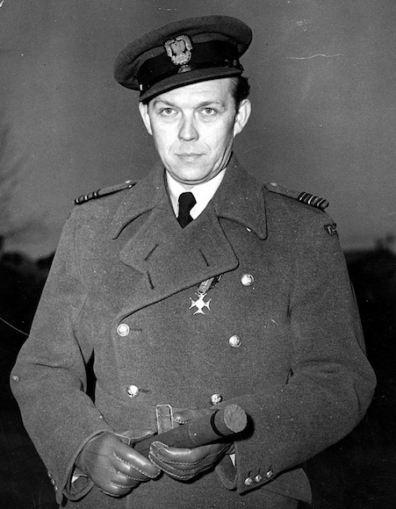
Aleksander Gabszewicz,
Narodowe Archiwum Cyfrowe collection – Public domain
From February 1946 to February 1947, the RAF Coltishall station commander was the rather stern Aleksander Gabszewicz, who had been born in Szawle in the Russian Empire in 1911. After the First World War, Szawle found itself in Lithuania. In 1931 Aleksander joined the Polish military, rising to be a tactical officer in the Polish airforce and escaping to England when Poland capitulated to the Germans in the first weeks of WW2. Quick off the mark at the outbreak of war (albeit closer to breakfast time than a minute past midnight), Aleksander shot down a Luftwaffe He-111 over Ciechanow at 9 am on September 1st 1939. Some historians claim this as the first German kill in World War Two.
The airfield is still there although covered in solar panels and with a prison built upon it. The runway remains intact and is used by the Norwich Model Aero Club. Pictured here, a member prepares to fly his model plane. A friend tells me that, according to the decals and colour scheme, it is a Junkers Ju87 Stuka Dive Bomber of the Sturzkampfgeschwader Siebenundsiebzig. Whatever that means.
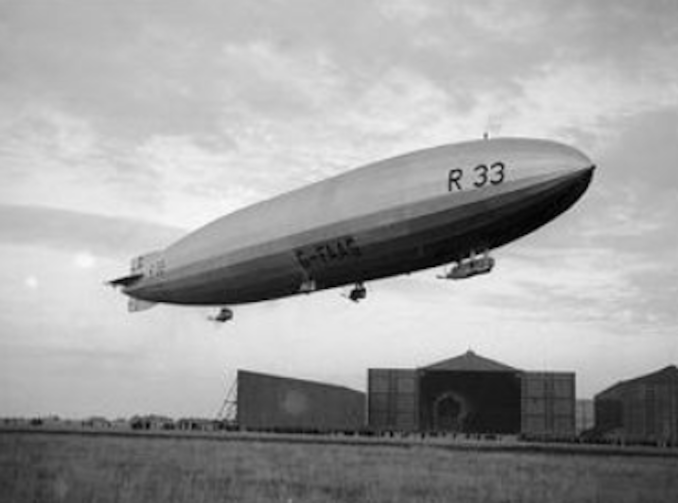
Airship R33,
Edward John Bennett – Licence CC BY-SA 3.0
Last time we took an interest in the Merriment and her crew. That wherry’s log for the 9th August 1919 included the following entry, “Naval Airship R33 and a semi-rigid sighted during the return journey.” Annotating his grandparent’s observations, Mr Rob Bruce added,
The R33 was then based at RAF Pulham St.Mary which is 18 miles south of Norwich. It had first flown on 6th March 1919 and its design had benefited from examination of a German Zeppelin brought down over English soil in 1916.
Merriment was fortunate to catch R33 as it was removed from service in 1921 after being damaged in a storm. At 643 ft long, and often with two bi-planes slung beneath, it must have been a remarkable sight over the Broads.
Thinking of wartime, when I first saw the following photo I assumed it was a three-span Bailey bridge thrown up in haste during the First World War. As usual, I was wrong.
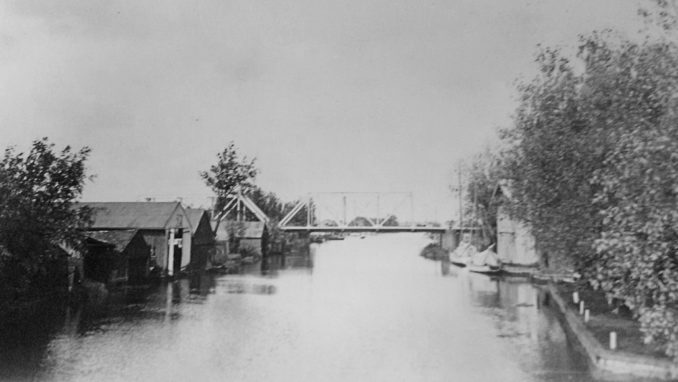
Further investigation showed it to be the old railway bridge at Potter Heigham, part of a Midland and Great Northern Railway Company line closed in 1959 and demolished in the mid-1960s. Potter Heigham station was on the Melton Constable to Great Yarmouth section of the Midland and Great Northern Joint Railway. It opened on the 1st January 1880 and closed on the 2nd March 1959. There was also a Potter Higham Bridge Halt which opened on 17th July 1933, closed in September 1939, reopened June 1948 and closed for the final time on 17th September 1958.
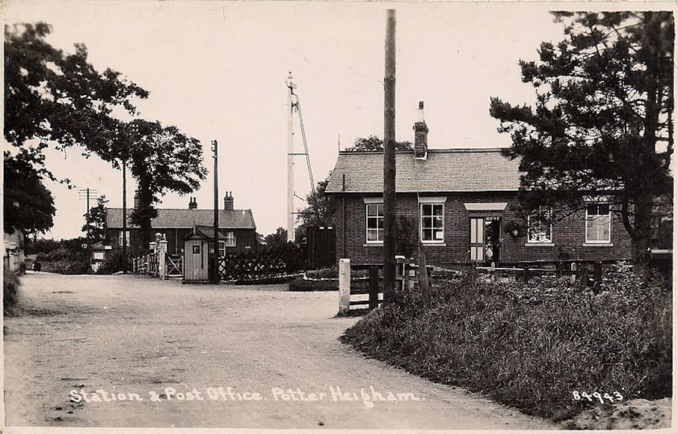
Potter Heigham railway station,
Old postcard – Public domain
After Potter Heigham Bridge Halt, the line progressed eastwards and southwards via Martham, Hemsby, Great Ormesby and Caister-on-sea to Yarmouth. And so, via the waterways, did our mystery family aboard Palace.
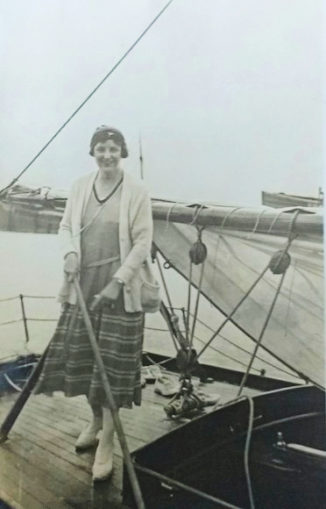
Pictured here we see a swabbing deckhand. In the background of the original photograph, the vessel to the right is clearly marked ‘YH’. Even this landlubber knows that commercial fishing vessels are registered in their home ports. The registration number begins with the first and last letter of the port, or if there’s a clash, with the first two. YH, therefore, marks this as a Yarmouth fishing boat.
Your author is one of those gentlemen of a certain age whose starting point is to assume that he can do anything – with often catastrophic consequences. Even so, the timber work, block and tackle, knots and fastenings to the right of the pictured lady crew suggests that this putting up a bit of cloth to catch the wind lark is a bit more difficult than the uninitiated might think. Note the pennant on the lady’s hat. All the different boat hire companies had different pennants, both flown from the top of the mast and worn as enamel badges.

Here we can see a steamboat in the background. Although Great Yarmouth is built-up, behind the township the River Yar widens before narrowing again. Steamboats were able to venture upstream at least as far as the Berney Arms Mill. As with pennants and badges, so with funnels. On the original reproduction, there is enough detail for the mind’s eye to take the smokestack on the right to be topped in black. Beneath which, two white rings are set over a third colour. This scheme suggests Bloomfields Ltd.
According to the Great Yarmouth Mercury, the last six of Bloomfield’s Yarmouth drifter-trawlers were sold to a Lowestoft company in 1963, thus marking the end of an era. The reason, according to Bloomfield’s managing director Mr J M C Cormack, was economic. “There is not enough fish,” he told the Mercury, “We cannot make a profit out of it.” The last of the Yarmouth steam drifters had been broken up two years earlier.
In contrast, 50 years previously close to the time of our mystery album, there had been more than 300 Yarmouth registered drifters fishing for herring. In those days, eight million herring could be landed – in one day. After the sale of the Bloomfield boats, autumn herring fishing continued on a small scale for a few more years before petering out, never to return.
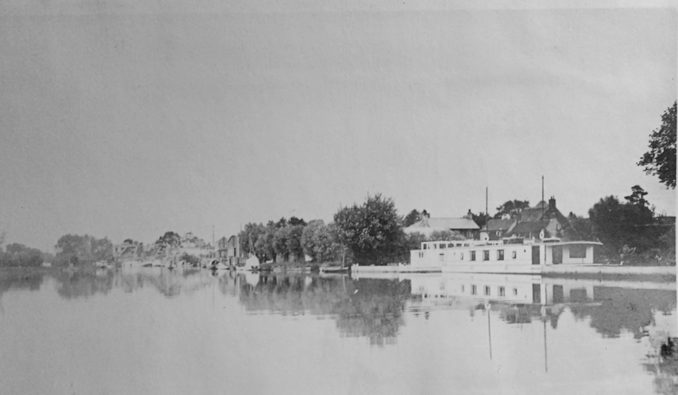
If not many ventured as far as Cottishall, many more ventured to the ancient village of Horning which sits on the River Bure about halfway between St Benet’s Abbey and Wroxham. The location is easily identified thanks to the presence of the Swan Inn.
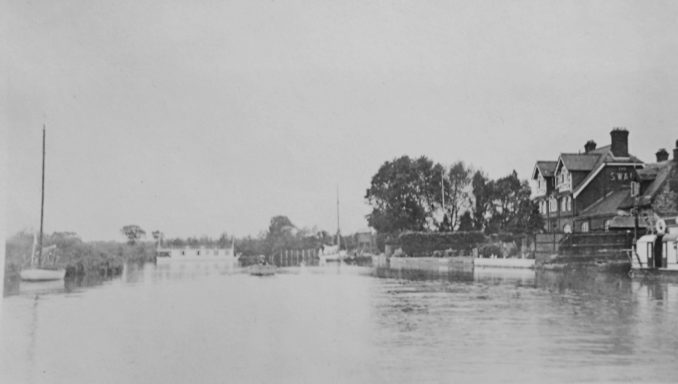
A closer look at the Swan (on the right-hand side), shows a white timbered upper story. Since then, the building has been ‘improved’. Recent photographs show the whole of the inn now presented in a mock Tudor style with a Mississippi paddle-steamer alongside. Dear God.
Still a popular hostelry, the Swan’s website states that a cottage was built on the site in 1696 with the basis of the present building being built in the early 19th century. It is mentioned in Arthur Ransom’s two Norfolk Broads adventures, 1934’s ‘Coot Club’ and 1940’s ‘The Big Six’.

As we bid farewell to the Broads, we observe our mystery crew at the dinner table. Note the awning above them and the upright piano behind. Note also the tablecloth, pots of preserve and a tea set that includes a Calcutta Cup style teapot.
Turning the next page of the album I’m presented with another trip. I have no idea where it is and, unless I have a bit of luck with my sleuthing in the meantime, Puffins will have to do most of the heavy lifting in the next episode of Mystery Album!
© text and photographs (unless otherwise credited) Always Worth Saying 2021



